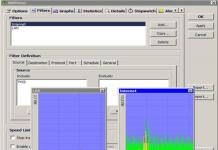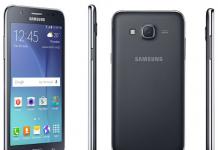Flagship smartphones should surprise. It’s not for nothing that these smartphones are the most expensive in the company’s lineup. Today we have a review, let's see what the flagship from Sony will surprise us with.
Video review of Sony Xperia XZ Premium
Thanks to TOLOKA coworking for the space for filming:
Design and ergonomics
The first thing that catches your eye is the rather large frames around the display. On the one hand, this may seem strange and out of place in the flagship of 2017, on the other hand, Sony does not go with the flow and does not strive to be like everyone else, for which they are a huge plus. The smartphone is very similar in size to any iPhone Plus version.
The top and bottom edges of the rectangular body of the Sony Xperia XZ Premium are made of metal, the side edges are made of plastic. The front and back are covered with Corning Gorilla Glass 5.

We tested a smartphone in its most “marked” design - Shining Chrome. It looks very unusual, arouses everyone's keen interest in the device, but it is very impractical, there will always be fingerprints on the smartphone - no matter how much you wipe it, a second after you take the XZ Premium in your hands - it is already dirty.

On the front panel, in addition to the screen, there are a pair of stereo speakers, a set of sensors, an indicator on the left above the screen and a front camera.
On the bottom edge there is a microphone and a USB Type-C connector, which, by the way, is standard 3.1, which is still not often seen even in flagship smartphones, and on the top edge there is a 3.5 mm headphone jack and an additional microphone.
The left side is occupied by a slot for a SIM card and a memory card, while the right side is occupied by the power and volume buttons, as well as the camera key typical of Sony smartphones.
Traditionally for Sony, the fingerprint scanner is built into the power key. This is a controversial decision; for example, it is inconvenient for left-handed people to use. The scanner works quickly, but unfortunately not always accurately.

On the back of the Sony Xperia XZ Premium, which may well serve as a mirror, the main camera, flash, infrared sensor, laser autofocus and NFC tag under the Xperia logo have found their place.
The build quality, as befits a flagship, is excellent. A pleasant advantage of the smartphone is moisture protection according to the IP65/68 standard.
Display
The 5.5-inch diagonal screen with 4K resolution (3840x2160 pixels) is made using IPS technology using proprietary TRILUMINOS technology. Pixel density is 807 ppi.

The viewing angles are excellent, the picture is readable in the sun and in general there are no complaints about the screen.
The screen resolution in the Xperia XZ Premium is, as they say, “with a reserve”, since 4K content is still quite small. But for use with glasses and headsets of augmented and virtual reality, this smartphone is perfect.
There is a proprietary utility with preset image display modes and the ability to customize color rendering.
Iron and shell
There is nothing unusual in the Xperia XZ Premium hardware, everything is quite typical for a 2017 flagship - Qualcomm Snapdragon 835 processor, Adreno 540 video core, 4 GB of RAM and 64 GB of storage. The smartphone supports MicroSD memory cards, but the slot for it is hybrid, so you have to choose either two SIM cards or a SIM/memory card.However, there is no hot swap; every time you remove the tray, the smartphone reboots - not very convenient.
The smartphone uses a new standard of built-in memory UFS - Universal Flash Storage, a new type of flash drive that works 4 times faster than eMMC. This qualitatively affects energy consumption, content processing speed and multitasking.
The range of wireless interfaces is extensive - dual-band Wi-Fi, Bluetooth 5.0 and NFC, as well as GPS (A-GPS supported) and GLONASS.
Sony Xperia XZ Premium runs on Android 7.1.1 Nougat OSown shell. It differs from “pure” Android only in redrawn icons and proprietary applications from Sony.
Everything works as it should be for a flagship - without any freezes or freezes. The smartphone handles any kind of toys with a bang, but when playing for a long time, the back cover starts to heat up a little.
Cameras
ABOUTThe main module, called Motion Eye, has a resolution of 19 megapixels, an f/2.0 aperture and a sensor size of 1/2.3 microns, an electronic stabilizer, phase and laser autofocus and an LED flash. The lens itself consists of six elements.
The main difference between Motion Eye and other lenses in smartphones is the presence of its own memory. What does this give? For example, super slow-motion video shooting at 960 fps.This video looks very impressive, but for a high-quality picture you need good light. In addition, it is very difficult to catch the right moment, because the smartphone captures such SlowMo for only 0.182 s and then stretches it out to 6 s.
The quality of photos in good lighting is excellent, it’s nice to scale and crop frames. In the evening it is more difficult to get a good shot - autofocus sometimes starts to miss.
The 13 MP front camera takes excellent selfies, but in poor light the picture starts to become slightly noisy.
Autonomy
The capacity of the built-in battery is 3230 mAh. The Xperia XZ Premium holds a charge from morning to late evening without any problems. If you don’t load your smartphone throughout the day, then it can handle even a day and a half on one charge.
The proprietary STAMINA power saving mode, which limits the performance of the smartphone, can further extend the operating time of the device without recharging. Thanks to support for Quick Charge 3.0 technology, the Sony XZ Premium charges up to 40 percent in half an hour and up to 100 percent in about an hour and a half.
conclusions
It will definitely find its buyer. An excellent 4K screen, flagship hardware and features such as moisture protection and video recording at 960 fps are a strong argument in favor of a smartphone from Sony. The only downside worth noting is that the case is very easily soiled.
Sony has made it a rule to present its flagship smartphones to the public at every well-known consumer electronics exhibition (MWC and IFA). As part of IFA 2016, the top representative of the Xperia line was announced - a model with the XZ index.
Unusual style
The stylish and unusual design instantly attracts the attention of others to the smartphone. Its aluminum alloy body looks solid and fits firmly in any hand. The only things that stand out from the overall picture are the large frames at the top and bottom of the screen. The display is made of 2.5D glass, under which is hidden a proprietary IPS matrix with FullHD resolution (1920x1080 pixels). With a 5.2" screen diagonal, there are absolutely no questions about the ease of operation with one hand or the readability of the picture. Moreover, the brightness reserve is enough for all life situations.
Power
At the heart of the smartphone is the Qualcomm Snapdragon 820 processor, typical for the entire family of flagships based on the Android OS. It works in tandem with 3 GB of RAM, handling the heaviest applications without any hesitation. The hardware power reserve will be enough for at least a year ahead. But the battery capacity looks somewhat underestimated for a top-end device and amounts to 2900 mAh. In contrast to the above, it is necessary to note the effective energy-saving algorithms of Sony phones, so you are unlikely to have to worry about the battery life.
Photo and video
An equally strong point of the Sony Xperia XZ is photo and video shooting. The main camera with an impressive 23 MP and a maximum aperture of f/2.0 boasts ultra-fast hybrid autofocus that captures the subject almost lightning fast, and the ability to record 4K videos. And the front camera with a resolution of 13 MP takes good selfies and can recognize faces.
Flagship
A fingerprint scanner, Qualcomm QuickCharge 3.0 fast charging, dust and moisture protection according to IP68 standard - the flow of flattering words about the smartphone is quite difficult to stop. And is it necessary? After all, he deserves them to the fullest.
Sony Xperia XZ Premium looks recognizable and moderately original. While many competitors are experimenting with additional or edge-to-edge screens, Sony continues to stick to its style.
The first thing that catches your eye is the angular shape of the body, the semicircular side ends, which become flat at the top and bottom. It is impossible not to note the huge frames around the screen, but this has already become a kind of calling card of Xperia flagships since the days. The only pity is that the touch buttons were placed not on them, but on the display, which is why the latter becomes somewhat smaller. stereo speakers are comfortably placed within the frame, but the feeling of unused space still lingers.
The back of the smartphone is fascinating. In Shiny Chrome, it looks like a shiny, mirror-like surface that you can look into to fix your hair or makeup. But this is not so practical - the phone attracts not only attention, but also small scratches.
On the left side you can see a cover under which the card slots are hidden. On the right there are three buttons at once - the volume rocker, the power key and the classic shutter button. In portrait mode, pressing it is not very comfortable, but it is useful in horizontal orientation of the phone. There is a fingerprint scanner hidden in the power key. This arrangement can be called convenient - it’s good that it is combined with the button that is used to unlock. I’m also glad that the 3.5 mm headphone jack has not disappeared anywhere and remains with the phone.
Dimensions of Sony Xperia XZ Premium: 156x77x8.1 mm, weight - 190 grams. As you can see, the smartphone is very large and quite comparable to a 5.9-inch phablet. It is slightly taller in height and width, but noticeably thicker, and weighs about the same. The phone fits well in the palm, but its corners slightly dig into the skin. You can control your smartphone with one hand, but it’s not very convenient.
The build quality of the Xperia XZ Premium is high. It is made of metal and protected by Gorilla Glass 5 on both sides. True, the glass gets dirty and slips easily, and due to the convex ends, the phone is not very convenient to take from the table.
One of the main features of the line is protection from water, and it hasn’t gone away this time either. The Xperia XZ Premium can withstand being submerged in water and will easily survive if you accidentally talk or talk on it in the rain. But you shouldn’t specifically bathe your smartphone—the manufacturer prohibits doing so under threat of voiding the warranty.
The Sony Xperia XZ Premium is available in three colours: Radiant Chrome, Deep Black and Rose Bronze.
Screen - 4.6
Sony Xperia XZ Premium has a 5.46-inch ultra-clear high-quality screen. Last year was the first phone with a 4K screen, and this year the XZ Premium became the first smartphone to support HDR video. But as in the case of its predecessor, this “pioneering” includes many reservations and formalities.
The display resolution is 3840x2160 pixels, the pixel density is simply fantastic - 807 per inch, which is even too much. True, the trick is that the phone interface and most third-party software are rendered in Full HD resolution. Full 4K is used only in the branded album, video player and only some applications. Perhaps the company has set its sights on virtual reality, but the problem is that most do not yet support 4K.
The situation with support for the HDR standard HDR10 is also complicated. HDR10 support is expressed in high screen brightness (up to 547 nits), wide color gamut (up to 99% of Adobe RGB) and a matrix with a color depth of 10 bits, and not the usual 8. But HDR10 requires suitable video content, which is not easy to find . But if you have it, then HDR support will come in handy - thanks to it, you can broadcast gameplay from the console to the smartphone screen.
As for the image quality, it is quite high. There is a wide range of brightness, from 5 to 547 nits, and a high contrast ratio of 1040:1. There are three color modes to choose from: Professional, Extreme Brightness and Standard. With the former, you get a fairly narrow color gamut of 97% of sRGB and very accurate color reproduction. This is perhaps the most practical option, since most content is created to this standard. If you want to see unusually saturated colors, go to maximum brightness mode. It expands the coverage to 99% of Adobe RGB, but at the same time the color accuracy drops slightly. This option is suitable for viewing HDR content or if you are a designer who works with an expanded color space. The “standard” option is something in between. By the way, in all three modes the color temperature turned out to be slightly too high, which is why the screen gets a slight blue tint. Fortunately, this can be corrected manually in the settings. Separately, we note the sensitive operating mode with gloves, which will be useful in winter.
Finally, let's talk about a small drawback - the screen does not display dynamic scenes very smoothly, which is why the image flickers a little. Perhaps this is due to the non-switchable dynamic backlight system. To check this by eye, just look through the desktops. If at the same time you do not notice how the icons flicker, then this will not be a problem for you.
Cameras - 4.7
Sony Xperia XZ Premium received top-end cameras of 19 and 13 MP, as well as the ability to shoot slow-motion video at 960 frames per second. The smartphone takes excellent pictures during the day, but in poor lighting it begins to give way to its competitors.
The device received the latest IMX400 module, which has a maximum resolution of 19 MP, an f/2.0 aperture, electronic optical stabilization, as well as phase tracking autofocus, supplemented by laser. When there is insufficient lighting, the LED flash comes to the rescue. Compared to , the number of megapixels has decreased, but the physical size of the matrix remains the same (1/2.3"), the pixel size is 1.22 microns. You can complain about the lack of optical stabilization and, as always, flirting with a large number of pixels. It is curious that almost all competitors have gone the route of dual cameras (, and so on), but not Sony. The company went its own way and added its own memory to the IMX400 module, which increased the shooting speed up to an incredible 960 frames per second. For comparison, it can only “slow down” to 240 frames per second.
As for the photo quality, during the day it is at a high level - with good color rendition, correct and fast focusing, and high detail. It seems that the company has even coped with the previously inherent unevenness in personnel. Sometimes only some of the colors look a little more saturated than in real life. But the camera doesn't handle low-light photography very well. Apparently, the lack of optical stabilization and the large number of pixels have an effect - noise immediately appears.
The camera interface itself seemed awkward to us. Switching between modes occurs either by pressing small icons at the top of the screen, or by swiping to the side. The first is inconvenient, and the second leads to the fact that sometimes an accidental press changes the shooting of a photo to a video recording or vice versa. In “Super Auto Mode” there have long been no restrictions on resolution or any parameters, but there is no separate icon for shooting HDR frames. HDR should turn on itself when necessary, but during tests of the Sony Xperia XZ Premium this did not always happen. As a result, in such cases, overexposed or dark frames are created.
Video shooting is possible both in 4K (3840×2160) at 30 frames per second, and in HD (1280×720) at 960 frames per second. This is truly impressive. The only problem is that you will need good lighting, because even in a fairly bright room these videos turn out to be “noisy”. It's better to shoot outside on a sunny day. There is also a time limit - you choose which part of the video will be slow-motion, but it will be literally a split second. You cannot extend the fragment, and the camera will need a timeout for a few seconds so that it can “recover” and be able to shoot another slow-motion fragment again.
The front camera of the phone can be called excellent; it is good for selfies. It has a high resolution of 13 MP, a good f/2.0 aperture and 1.12 micron pixels. The maximum resolution for video recording is 1920×1080 pixels. But most importantly, there is autofocus, which will always allow you to take clear selfies. Add here beautifying filters, a simple manual mode and HDR shooting, and we will see that the front camera of the Sony Xperia XZ Premium is quite comparable to the main cameras of mid-price smartphones.
Photos from camera Sony Xperia XZ Premium - 4.7
Sony Xperia XZ Premium, HDR photo comparison
Photos from the front camera of Sony Xperia XZ Premium - 4.7
Working with text - 5.0
The phone comes with a SwiftKey keyboard out of the box. It offers many themes and supports continuous input (Swype), and there is also markup of additional characters. In addition, you can adjust the size of the keyboard, change the layout, or even move it entirely across the screen.
Internet - 3.0
The Google Chrome browser is pre-installed on the phone. It can be called the standard option for many Android devices. Its main feature is synchronization with the desktop version. But mobile Chrome does not have a full reading mode or automatic adjustment of text to the width of the screen.
Communications - 5.0
Sony Xperia XZ Premium has a large number of communication capabilities and support for the latest technologies. The smartphone received the following features:
- Wi-Fi 802.11 a/b/g/n/ac, Wi-Fi Direct, DLNA
- LTE, up to 1 Gbit/150 Mbit
- Bluetooth 5.0 LE, A2DP, aptX HD
- GPS with A-GPS, GLONASS, Galileo, Beidou
- NFC chip.
At the bottom end there is a USB v3.1 Type-C connector with USB On-The-Go support for connecting type peripheral devices. It would be possible to add only FM radio and an infrared port, which are not here.
Two modifications of the device will go on sale: version G8141 with the ability to install one nanoSIM and Xperia XZ Premium Dual (G8142) with support for two nanoSIM cards. However, in the second case, the slot for the second one will be combined with a memory card. Moreover, every time you open the tray cover, the phone goes into a time-consuming reboot.
Multimedia - 4.4
The smartphone can well be called a multimedia one. According to the test results, it turned out to be not the most “omnivorous”, but it provides high sound quality.
For music, the phone did not want to be friends with AC3; for video, it did not want to be friends with RMVB, TS and some WMV videos. As for the sound, the phone does not have a very large volume reserve, but it sounds high quality. The most interesting thing is that the smartphone has support for Hi-Res audio. Moreover, the audio player itself sees the tracks in “high resolution” and marks them with the letters HR. The sound quality for them becomes noticeably higher. So, for regular audio, the dynamic range was 85.5 dB, something around the average value. But in the case of Hi-Res audio, it jumps to 90.5 dB, and this already makes it one of the leaders in this parameter among.
The proprietary music player offers not only an equalizer with the ability to add bass, but also a number of sound effects such as surround sound in or out of the speakers, as well as a normalizer for equalizing the volume of different songs.
The video player has an interesting feature - it allows you to enlarge the image directly while watching a video. This looks especially impressive when watching 4K videos, when you start zooming in on the picture several times, and it still looks clear. It can also work with subtitles and play videos in the background when working with other applications.
Performance - 4.9
The performance of the Sony Xperia XZ Premium can be called flagship high. Any games and applications are not a problem for it.
Xperia XZ Premium is one of the first smartphones with a powerful Qualcomm Snapdragon 835 chipset (four cores at 2.45 GHz and four at 1.9 GHz) and Adreno 540 graphics. The amount of RAM is 4 GB. During the tests, the phone worked smoothly and easily carried out any tasks and applications. The only thing I didn’t like was the long boot time of the device itself when turned on, up to 50 seconds. The same one from last year launches almost twice as fast. In addition, we checked whether the device body does not heat up during operation. It turned out that no - only up to 40.6 degrees on the display after half an hour in games. Warm, but not hot.
In benchmarks, the Sony Xperia XZ Premium received the following results:
- Geekbench 4 (CPU test) - 6152 points, about twice as high;
- Ice Storm Unlimited from 3DMark (graphics) - 39717, a very high result, can only be compared with Xiaomi Mi6 on the same platform;
- AnTuTu 6 (mixed test) - 162729 points, almost a third higher than Huawei P10.
Battery - 3.6
The autonomy of the Xperia XZ Premium can be called mediocre. We only had enough smartphone for a day of active use. This is normal, but you always expect more from a flagship.
The manufacturer equipped the smartphone with a 3230 mAh non-removable battery. For comparison, the y has 3400 mAh, and the y has 3060 mAh. In battery tests, the phone showed the following results:
- Only 5 hours of video viewing at maximum brightness and up to 7.5 hours if you reduce it to 200 nits. Even the iPhone 7 with a small battery lasted longer.
- 127 hours of music listening, comparable to . It's a good time, the screen off does its job.
- About 4 hours in games, slightly better than average.
- Half an hour of shooting Full HD video consumes 15% of the battery.
In general, if you don’t play a lot and don’t get carried away with watching multimedia content, then the phone can last for a longer time, especially in tandem with the energy-efficient Stamina mode.
Note that the Xperia XZ Premium supports QuickCharge 3.0 fast charging, but it does not come with a suitable charger. And it’s unclear whether they forgot to put it in, or saved on an important feature. By the way, the smartphone is fully charged in just over 2.5 hours.
Memory - 5.0
With super slow motion video shooting, the Xperia XZ Premium requires fast storage. Therefore, the device is equipped with 64 GB of internal memory with a write speed of up to 1.5 GB per second. Of these, about 50 GB are available to the user. In fact, video shooters will easily fill this volume. In this case, you can add up to 256 GB using a microSD card. It's funny, but the smartphone does not support hot-swapping of cards - as soon as you open the tray slightly, the phone goes into reboot. There is no provision for installing applications on external memory. You are only asked to transfer music, videos and photos to the card.
Peculiarities
The smartphone case is protected from moisture and dust according to the IP68 standard. Thanks to this, the Xperia XZ Premium can spend up to half an hour underwater at a depth of 1.5 meters. The phone can also shoot super slow-motion video at 960 frames per second. Another important feature is the 4K display with HDR video support. Fans of the PlayStation 4 game console will appreciate Remote Play - the ability to play the console remotely from a smartphone.
The software part is handled by a proprietary interface from Sony, which offers you your own keyboard, players, album, and even the Xperia Store.
Last year, Sony surprised a lot: the company released, in fact, two flagships in one year. First, as part of the new series, the Japanese showed the Xperia X Performance - it was the most powerful of the new smartphones, so it seemed that this was the flagship. However, a little later, the company made the Xperia XZ - a device with a similar filling, but a larger screen and a new design concept, which suddenly became the new leader of the family. Perhaps the company was dissatisfied with the sales, or maybe this was a cunning marketing ploy, the essence of which none of the ordinary people understood. One way or another, Sony is doing things differently this year, updating the entire series at once.
The leader of the lineup is the Xperia XZ Premium, which is conceptually similar to the Xperia X5 Premium, and the successor to the previous flagship, the Xperia XZs, becomes a more compact and affordable alternative. Well, the Xperia XA1 and XA1 Ultra are competing in the first league this season. It seems that Sony is trying to build a single line from different models of past years and think more about quality than quantity. Well, let's see how good the new Xperia flagship is and what it can do against the market leader in .
⇡ Technical specifications
| Sony Xperia XZ Premium | Sony Xperia Z5 Premium | Huawei P10 Plus | Samsung Galaxy S8 | HTC U Ultra | |
|---|---|---|---|---|---|
| Screen | 5.46 inches, IPS, 3840 × 2160 pixels, 807 ppi, capacitive multi-touch | 5.5 inches, IPS, 2160 × 3840 pixels, 806 ppi, capacitive multi-touch | 5.5 inches, IPS, 2560 × 1440 pixels, 540 ppi, capacitive multi-touch | 5.8 inches, Super AMOLED, 1440 × 2960 pixels, 570 ppi, capacitive multi-touch | 5.7 inches, IPS, 2560 × 1440 pixels, 513 ppi, capacitive multi-touch + second display, 2.05 inches, 1040 × 160 |
| Protective glass | Corning Gorilla Glass 5 | No data | Corning Gorilla Glass 5 | Corning Gorilla Glass 5 | Corning Gorilla Glass 5 |
| CPU | Qualcomm Snapdragon 835 (MSM8998): eight cores (4 × 2.45 GHz + 4 × 1.9 GHz) | Qualcomm Snapdragon 810 (MSM8994): eight cores (4 × 1.5 GHz + 2 × 2.0 GHz Cortex-A57) | HiSilicon Kirin 960: eight cores (4 × 2.4 GHz ARM Cortex-A73 + 4 × 1.8 GHz ARM Cortex-A53) | Samsung Exynos 8895: eight cores (4 × M1, 2.5 GHz + 4 × Cortex-A53, 1.69 GHz) | Qualcomm Snapdragon 821 MSM8996 (Dual 2.35GHz Kryo Cores + Dual 1.36GHz Kryo Cores) |
| Graphics controller | Adreno 540, 710 MHz | Adreno 520, 600 MHz | ARM Mali-G71 MP8, 900 MHz | Mali-G71 MP20, 850 MHz | Adreno 530, 624 MHz |
| RAM | 4 GB | 3 GB | 4/6 GB | 4 GB | 4 GB |
| Flash memory | 64 GB | 32 GB | 64/128 GB | 64 GB | 64/128 GB |
| Connectors | 1 × USB Type-C | 1 × microUSB | 1 × USB Type-C | 1 × USB Type-C | 1 × USB Type-C |
| 1 × 3.5mm headset jack | 1 × 3.5mm headset jack | 1 × 3.5mm headset jack | |||
| 1 × nano-SIM; | 1 × nano-SIM; 1 × microSD |
1 × nano-SIM; 1 × microSD |
2 × nano-SIM | 1 × nano-SIM; 1 × microSD |
|
| 1 × microSD / 1 × nanoSIM/microSD | 1 × microSD | ||||
| Cellular connection 2G | GSM/GPRS/Edge 850/900/1800/1900 | GSM/GPRS/EDGE 850/900/1800/1900 MHz | GSM/GPRS/EDGE 850/900/1800/1900 MHz | GSM/GPRS/EDGE 850/900/1800/1900 MHz | |
| Cellular 3G | HSDPA 800/850/900/ 1700/1900/2100 |
HSDPA 800/850/900/ 1700/1900/2100 |
DC-HSPA 850/900/ 1900/2100 MHz |
1700/1900/2100 |
UMTS/HSPA+/DC-HSDPA 800/850/900/ 1700/1900/2100 |
| Cellular 4G | LTE Cat.16 (1024 Mbps, 150 Mbps), bands 1, 2, 3, 4, 5, 7, 8, 12, 13, 17, 19, 20, 26, 28, 29, 32, 38 , 39, 40, 41 | LTE Cat. 4 (150 Mbit/s, 50 Mbit/s), bands 1, 2, 3, 4, 5, 7, 8, 12, 13, 17, 19, 20, 26, 28, 29, 32, 38, 39, 40, 41 | LTE Cat. 4 (150 Mbit/s, 50 Mbit/s), bands 1, 2, 3, 4, 5, 7, 8, 18, 19, 26, 28, 38, 40, 41 | LTE Cat.16 (1024 Mbps, 150 Mbps), bands 1, 2, 3, 4, 5, 7, 8, 17, 20, 28 | LTE Cat.11 (up to 600 Mbps): bands 1, 2, 3, 4, 5, 7, 8, 12, 17, 20, 28, 38, 39, 40, 41 |
| WiFi | 802.11 a/b/g/n/ac 2.4/5 GHz | 802.11 a/b/g/n/ac 2.4/5 GHz | 802.11 a/b/g/n/ac 2.4/5 GHz | 802.11 a/b/g/n/ac 2.4/5 GHz | 802.11 a/b/g/n/ac 2.4/5 GHz |
| Bluetooth | 5.0 | 4.1 | 4.2 | 5.0 | 4.2 |
| NFC | Eat | Eat | Eat | Eat | Eat |
| Navigation | GPS, A-GPS, GLONASS, Galileo | GPS, A-GPS, GLONASS | GPS, A-GPS, GLONASS | GPS, A-GPS, GLONASS, BeiDou, Galileo | GPS, A-GPS, GLONASS, BeiDou |
| Sensors | Illumination, proximity, accelerometer/ gyroscope, magnetometer (digital compass) |
Illumination, proximity, accelerometer/gyroscope, magnetometer (digital compass) | Illumination, proximity, accelerometer/gyroscope, magnetometer (digital compass), Hall sensor | Illumination, proximity, accelerometer/gyroscope, magnetometer (digital compass), Sensor Hub | |
| Fingerprint's scanner | Eat | Eat | Eat | Eat | Eat |
| Main camera | 19 MP, ƒ/2.0, laser + phase-contrast autofocus, LED flash, 4K video recording, HD video recording at 960 fps | 23 MP, ƒ/2.0, laser + phase-contrast autofocus, LED flash, 4K video recording |
2 × 12 MP, ƒ/1.8, laser autofocus, LED flash, 4K video recording | 12 MP, ƒ/1.7, phase detection autofocus, optical stabilization, LED flash | 12 MP, ƒ/1.8, hybrid autofocus (contrast with laser illumination + phase detection), optical stabilization, LED flash, 4K video recording |
| Front-camera | 13 MP, ƒ/2.0, contrast autofocus, Full HD video recording | 5.1 MP, ƒ/2.4, Contrast autofocus, Full HD video recording |
8 MP, contrast autofocus, no flash | 8 MP, ƒ/1.7, autofocus, no separate flash | 16 MP, fixed autofocus |
| Nutrition | Non-removable battery: 12.2 Wh (3230 mAh, 3.8 V) | Non-removable battery: 13 Wh (3430 mAh, 3.8 V) | Non-removable battery: 14.25 Wh (3750 mAh, 3.8 V) | Non-removable battery: 11.4 Wh (3000 mAh, 3.8 V) | |
| Size | 156 × 77 × 7.9 mm | 154.1 × 75.8 × 7.8 mm | 153.5 × 74.2 × 7 mm | 148.9 × 68.1 × 8 mm | 162.4 × 79.8 × 8 mm |
| Weight | 191 g | 180 g | 165 g | 155 g | 170 g |
| Water and dust protection | Yes, IP68 standard | Yes, IP68 standard | No | Yes, IP68 standard | No |
| operating system | Android 7.1 Nougat | Android 5.0 Lollipop (Android 7.0 Nougat supported) | Android 7.0 Nougat, EMUI 5.1 shell | Android 7.0 Nougat, Grace UX shell | Android 7.0 Nougat, HTC Sense's own shell |
| Current price | 54,990 rubles | 45,990 rubles | 44,990 rubles | 59,990 rubles | 49,000 rubles |
|
|
|
|
⇡ Design, ergonomics and software
At first glance, there is nothing special for Sony and nothing new. The current flagship is made in the usual Sony style and is similar to the Xperia XZ, increased in size - the same sharp edges, the same large space at the top and bottom. The ratio of the screen area to the total front surface is not at all impressive - only 68: 100. Compare this with the Samsung Galaxy S8 and its 83: 100. However, it should be noted that the side frames remain quite thin, and the protective glass extends slightly onto the side edges, which affects the visual perception of the smartphone.

As befits a flagship in 2017, the Xperia XZ Premium is made of glass and metal. The front and back panels are completely covered with Gorilla Glass 5. It is interesting that in the silver version of the smartphone the back panel is mirrored, you can look into it, and girls really like it. Apart from the silver variant, the Xperia XZ Premium is available in black and pink. True, the latter option has not yet begun to be sold in Russia.

The side edges are very smooth, rounded, the smartphone is comfortable to hold in your hand, despite its impressive size - I had approximately the same sensations when working with the iPhone 7 Plus. But straight lines at the top and bottom can cause discomfort for those who are used to carrying a smartphone in the front pocket of their jeans. Here Sony is repeating the mistakes made by the designers of the rectangular Lumia on Windows Phone.
|
|
|
The location of the main elements on the body has not changed. At the top there is a 3.5 mm audio jack. It's nice that Sony doesn't follow the dubious trend that Apple and HTC have picked up and doesn't force you to switch to wireless headphones or models with a USB-C connector.

At the bottom is USB Type-C, which has become a new standard, and on the right edge there are volume keys, a power button (with a built-in fingerprint scanner) and a camera launch button. On the left side there is a compartment for SIM cards and a microSD flash drive. The traditional “trouble” of Sony smartphones is that every time this tray is removed, the device automatically goes into reboot, despite the fact that there are no technical restrictions for hot-swapping a SIM card and microSD drive for a long time.
|
|
|
In terms of dimensions, the Xperia XZ Premium cannot surprise: the thickness of 7.9 millimeters has not been impressive for a long time, and the width of 77 mm allows you to somehow work with the smartphone with one hand - you can enter text without problems, but it’s not easy to reach the top edge. And of course, it must be said that the smartphone is too heavy - it weighs 191 grams. It's even slightly heavier than the iPhone 7 Plus, which today feels overly weighty. In addition, I have big concerns about reliability - a heavy smartphone is easier to break. Owners of the Xperia Z5 Premium actively complained about fragility, because even a fall from a height of 60-70 centimeters led to cracks on the back panel or on the screen. In general, I did not test the XZ Premium for durability, but I advise you to use it with extreme caution.

But there is good news: protection from dust and moisture is still here. Sony Xperia XZ Premium complies with the IP68 standard and can withstand a half-hour stay under water at a depth of one and a half meters. And the presence of a dedicated shooting key makes it suitable for underwater shooting. True, the manufacturer emphasizes that this is just an ordinary rugged smartphone, and not a full-fledged underwater device.
|
|
|
Returning to the dedicated button for the camera, we should note the possibility of a quick launch: you can point your smartphone at the object with the screen turned off and press the camera key - a photo will be taken. In some situations, the saved second can make a difference, so the function will definitely be useful.
In high-impedance (60 Ohm) monitor headphones, the low frequencies are worked out perfectly, but they always work in moderation and legibly - sorry, it doesn’t reach the point of “farting” even at maximum volume. The volume is excellent, the “middle” flows tightly through it, and the high frequencies rattle with accents. That is, they do not whistle into your ears on an ongoing basis, but are separated from the rest of the range. But they work much more clearly than in conventional flagships based on Snapdragon (Xiaomi Mi 6, OnePlus 3), and this turns out to be enough.
Although for those who like to reconfigure everything in their own way, there are also plenty of options:
DSEE HX- an analogue of Samsung’s UHQ Upscaler, a cunning algorithm that completes the audio stream of lossy (mp3, ogg vorbis) audio files, if not to lossless formats, then to a slightly higher level than what is “hardwired” in the file itself. In MP3 files with an initially high-quality spectrum, it “presses up” the low frequencies, adding a little volume and clarity.
ClearAudio+- brings high frequencies to the fore and makes them clearer. Moreover, it does it quite competently - it does not introduce any metallic shades or other nonsense pornography into the sound. Without it, it’s also not bad, but as a recipe from “boyish” mastering (when music was recorded with the aim of “pumping the bottom”), it’s a very successful option.
Surround Sound (VPT)- “not for everyone” function. It distorts the sound in different ways and introduces an artificial “concert” echo.
There is also a 6-band equalizer that you can turn on instead of DSEE HX or ClearAudio+. Nothing remarkable, except for separate bass adjustment Clear Bass- “Bubnelka” is very smart and thinks up the “low” in a different way than if you simply raise the frequency response graph in Poweramp, for example.
It's in the monitors. And in the “plugs” of the Xiaomi Hybrid Pro HD (32 Ohm) level, the low frequencies are most often slightly lacking, and the clarity seems excessive - after 15 minutes you will either get used to it or get ringing in your ears. And this is strange, because Sony claims that the smartphone determines the type of headphones independently, using the AHO system. But de facto, with ClearAudio+ the sound becomes caustic and impossible to listen to, and DSEE HX makes the scene “dense,” but ringing high frequencies are still annoying, and there is no longer access to the equalizer with the option activated. The output is a slight “boost” in Clear Bass and a decrease in detail in the “twist” of the 16 kHz range. Beauty!
As an option “I want great sound at the touch of a button,” the LG G6 with Quad DAC looks brighter (the Koreans finally taught their flagship to properly adjust the sound to the type of headphones without additional questions), but Samsung in the Galaxy S8 was disappointed with the “dirty” sound for a flagship and “ damage" to the sound at the slightest intervention in the equalizer. Now the Galaxy S8 sounds on par with the Xperia XZ Premium only with the additional activation of UHQ Upscaler, and if you use the “enhancers”, Sony takes the lead. Surprisingly, this is what appears to be the victory of the standard WCD9341 DAC in the Snapdragon 835 over the more prestigious Cirrus Logis in the Exynos 8895.
Iron
Last year, the description of smartphones based on the top-end Snapdragon was given more simply. Like, look - another mobile phone running the fastest chipset, and no more explanation is needed. In 2017, the stars were positioned a little differently, so we’ll have to start from afar.
Qualcomm is a proud bird, until you kick it and motivate it, it won’t fly. After hot Californian guys disgraced themselves with the hot Chinese Snapdragon 810 in 2015, and Samsung with its more advanced factories and Galaxy S6 beat all competitors in benchmarks, the American chipmaker made every effort to make the new generation processor a masterpiece.



































